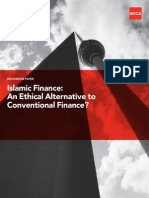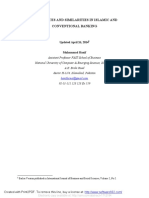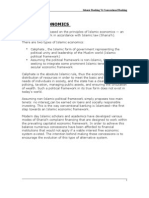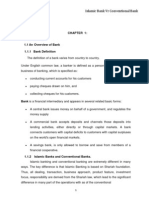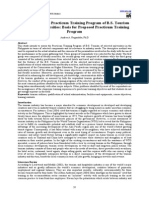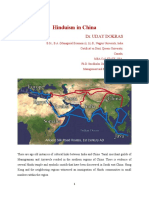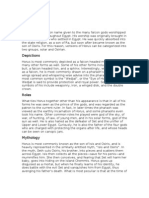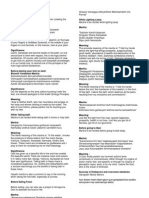Challenges Facing The Development of Islamic Banking PDF
Challenges Facing The Development of Islamic Banking PDF
Uploaded by
Alexander DeckerCopyright:
Available Formats
Challenges Facing The Development of Islamic Banking PDF
Challenges Facing The Development of Islamic Banking PDF
Uploaded by
Alexander DeckerOriginal Description:
Original Title
Copyright
Available Formats
Share this document
Did you find this document useful?
Is this content inappropriate?
Copyright:
Available Formats
Challenges Facing The Development of Islamic Banking PDF
Challenges Facing The Development of Islamic Banking PDF
Uploaded by
Alexander DeckerCopyright:
Available Formats
European Journal of Business and Management ISSN 2222-1905 (Paper) ISSN 2222-2839 (Online) Vol.5, No.
22, 2013
www.iiste.org
Challenges Facing the Development of Islamic Banking. Lessons from the Kenyan Experience
Shamim Njeri Kinyanjui Jomo Kenyatta University of Agriculture and Technology Abstract The purpose of the study was to investigate the challenges facing the development of Islamic banking in Kenya. The research designed for study was a case study approach focusing on four Islamic compliant banks in Kenya. These are: - First Community Bank; Gulf African Bank; Dubai Bank; Kenya commercial Bank Ltd and Barclays Bank Ltd. The population of the study consisted of 33 customers, who were the holders of accounts in the respective banks and 11 managers. Sample data collected by use of questionnaires administered by the researcher and a research assistant. Data analysis method used is based on the quantitative approach using descriptive statistics: mean, mode, and median. Frequency tabulations and cross tabulations were used to bring out the finding of the study. The study revealed Islamic banking compliant was driven by religious compliance and customers need being met. It also revealed that continuous review and improvement of shariah compliant products together with diversifying market niche will lead to drastic development and marketing of Islamic banking products. From the study the following conclusions were drawn: firstly, the factors that influence development of Islamic banking products in Kenya are purely religious compliance and customers need being met. Keyword: Islamic Banking. 1.1 Introduction There is no satisfactory definition of a bank and term bank, as such, may apply to an organization, a financial institution operated by an individual as sole proprietor, partnership, a corporation or other type of association, in modern use it is an establishment for the custody of money (Saddiqi, 1986). One definition of an Islamic Bank is a bank that, by its own choice, opts to comply with two sets of law: the law of the Land (Jurisdiction); and the Islamic Law (Shari'ah). This is why Islamic bankers have two types of legal counsel: traditional ``lawyers'' and ``Shari'ah Councils'' (Al-Bahar, 1996). As Islamic finance is intertwined within its religion, the basis of the religion affects the finance in two important ways: ``Islam aims at building a socio-economic order based on justice and considers economic activity as a means to an end and not an end in itself. It enjoins Muslims to harness natural resources, which are a trust from Allah( God) , for carrying out rightful activities; but abhors exploitation and man-made inequalities of income and wealth.'' ``Islam is deeply concerned with the problem of economic development, but treats this as an important part of a wider problem, that of total human development. The primary function of Islam is to guide human development on correct lines and in the right direction. It deals with all aspects of economic development but always in the framework of total human development and never in a form divorced from this perspective'' (Al-Harran, 1993). Islamic banking has the same purpose as conventional banking except that it operates in accordance with the rules of Shariah, known as Fiqh al-Muamalat (Islamic rules on transactions). The basic principle of Islamic banking is the sharing of profit and loss and the prohibition of riba (usury/interest). Common terms used in Islamic banking include; profit sharing (Mudharabah), safekeeping (Wadiah), joint venture (Musharakah), cost plus (Murabahah), and leasing (Ijarah). In an Islamic mortgage transaction, instead of loaning the buyer money to purchase the item, a bank might buy the item itself from the seller, and re-sell it to the buyer at a profit, while allowing the buyer to pay the bank in installments. However, the bank's profit cannot be made explicit and therefore there are no additional penalties for late payment. In order to protect itself against default, the bank asks for strict collateral. The goods or land is registered to the name of the buyer from the start of the transaction. This arrangement is called Murabaha. Another approach is EIjara wa EIqtina, which is similar to real estate leasing. Islamic banks handle loans for vehicles in a similar way by selling the vehicle at a higher-than-market price to the debtor and then retaining ownership of the vehicle until the loan is paid (Kahf, 2004). An interest free Islamic bank in relation to its clients plays the role of partner, investor and trader. The interest free modes of operation designed by Islamic financial institutions satisfy the criteria God permits trading and forbid riba. Keeping in view of the Islamic injunctions against taking and giving of interest, the Islamic banks
94
European Journal of Business and Management ISSN 2222-1905 (Paper) ISSN 2222-2839 (Online) Vol.5, No.22, 2013
www.iiste.org
have organized their operations on the basis of profit /loss sharing which is permitted in Islam. Islamic banks accept demand deposits and time deposits. Demand deposit are fully repayable on demand and do not get any return, holder of time deposits are given a share in the profit earned by the bank according to a profit sharing rates made known in advance. 1.2 Problem Statement The study carried out by Gerrald in the year 1997 found that: Islamic religious belief and social responsibility are the two most important factors that determine bank selection. Cost benefit is the third most important factor considered in bank selection. Clients of conventional and Islamic banks share a number of motives, but they differ significantly on a few motives in relation to bank selection, the clients of Islamic banks are more familiar with the products/services that conform to the Shariah. However, the study by Erol and El-Bdour (1989) contradict the findings of other studies and argue that religious motivation did not appear to play a primary role in bank selection. Significant number of customers would withdraw their deposits if an Islamic bank did not generate sufficient profit to make a distribution in any one year hence motivated by higher dividend payments instead. Further, the results of the study by Oundo (2009) suggested that there was poor supply of Shariahcompliant products in Kenyas financial institution. The challenges in the supply side of Shariah compliant financial services was illustrated by one bank that wrote Cheques to suppliers for their Muslim clients who were uncomfortable with receiving credit in cash against the Shariah. There was high demand for Islamic financial products against a negligible supply of the same meaning that Islamic finance clients had few options (if any) and financially neglected by the microfinance sector. According to Ndungu (2010) Kenya was the first country in the East and Central African region to introduce Islamic banking in the year 2007. In this short period, two banks were licensed to exclusively offer Shariah-compliant products with many other conventional banks establishing a window specifically for Shariah-compliant products. He noted that the concept of shariah complaint banking has emerged as an alternative vehicle for mobilization and supply of finance. For example, the two banks have already contributed in development agenda of the country by participating in Shariahcompliant (Sukuks) components of infrastructure bonds issued by the Central Bank of Kenya on behalf of the Government of Kenya and Structured Sukuk is expected to cover the bonds and T-Bills market in future. However, although the concept of Islamic Finance has generated a lot of interest and overwhelming support from both Muslim and non-Muslim population in Kenya, as a regulator, CBK has faced by certain challenges which need to be addressed. In their short period of existence, Islamic banking in Kenya has shown very commendable performance commanding combined market share of the banking sector in terms of gross assets of 0.8%. Currently there are two Islamic banks operating in Kenya: Gulf African and First Community bank, which had a loan portfolio of 4.9-billion shillings, deposits totaling 7.5billion shillings and 27270 deposit accounts. These indicators point to the tremendous potential of this market niche, which has been previously untapped, largely comprising Muslims estimated to make up at least 15% of Kenya's population of 36-million (Muriri, 2009). To address the above challenges highlighted by Central Bank of Kenya, this study seeks to establish factors influencing the development of Islamic banking in Kenya. 2.0 Literature Review 2.1 Islamic Banking Instruments The Islamic banking model primarily relies on the instruments of mudarabah (joint venture) and musharakah (equity participation) to eliminate interest from the financial sector and economy. Other interest-free instruments such as murabaha (deferred payment sale), ijarah (leasing), bai Salam (advance payment) and bai istisna (procurement engagement) are also used to enhance the practical scope, diversification and risk management capabilities of the Islamic banking system. 2.1.1 Profit and loss sharing (PLS) Theory Islamic scholars treat PLS instruments, mudarabah and musharakah as a central pillar of the Islamic banking model. In mudarabah banking, the Islamic bank accepts funds from depositors under risk-sharing arrangements. The Islamic bank either directly invests these funds in profitable investments or extends them to entrepreneurs on a risk-sharing basis. The Islamic bank shares the profit or loss made on mudarabah ventures with its depositors. In musharakah banking, the Islamic bank contributes the depositors' funds to a joint enterprise with
95
European Journal of Business and Management ISSN 2222-1905 (Paper) ISSN 2222-2839 (Online) Vol.5, No.22, 2013
www.iiste.org
the client (an entrepreneur). Generally, the Islamic bank allows the client to manage all the affairs of a Musharakah business. The Islamic bank and the client mutually share the profit or loss made on the Musharakah investment. In a typical PLS arrangement, an Islamic bank provides the risk capital to a firm in which professional managers are responsible for making strategic and operational decisions. The bank shares in profits and is liable to any financial loss. There is no serious problem with this arrangement if the bank is able, and is allowed, to monitor business operations of the firm. However, proper monitoring mechanisms are yet to be devised for PLS, especially in case of Mudaraba that does not provide any control rights to the financier (the Islamic bank in this case). Fiqh literature on this issue is quite out-of-date and needs serious reconsideration. For example, Saleh (1986) lists three rights and one responsibility of the financier in a Mudaraba arrangement. The rights include ensuring that the borrowing entrepreneur (firm) complies with the terms of the contract, sharing profits, and limited liability in case of loss. The sole responsibility is handing over the Mudaraba capital. He also outlines two rights and two responsibilities of the borrower. The rights include conducting the business with an appropriate degree of freedom, and accounting decisions. The responsibilities are compliance with the terms of the contract, and liquidation of the Mudaraba business at the end of the contract. The modern use of Mudaraba as a mode of financing obviously requires more than such preliminary specification of rights and responsibilities. There is a need for construction of standardized PLS contracts, or bylaws, in the light of the legal frameworks of Muslim countries. A prominent feature of these bylaws should be definition of the rights and obligations of various officers or groups within the organizational structure. Similar bylaws should delineate the clauses related to performance of the borrowing firm compared with other firms in the same sector and, possibly, other firms. 2.1.2 Murabaha (deferred payment sale): theory and practice Under the Murabaha arrangement, the client makes a promise to buy specified goods from the Islamic bank on a deferred payment basis. The Islamic bank purchases goods from the original supplier and sells them on to the client after adding its own profit margin. The legality of murabaha could not be established from the primary sources of Islamic Shariah, i.e. the holy Quran and Sunnah. The early Islamic jurists, such as Imam Malik (796) and Imam Shafi (820), approved murabaha sales but they did not refer to the increase in price in the case of deferred payment. Subsequently, certain other Islamic jurists, such as Sarakhsi (1091), Marghinani (1197) and Nawawi (1277), allowed the seller to charge a higher price in the deferred payment sale by characterizing it as a normal trade practice (Saadullah, 1994; Vogel and Hayes, 1998). Contemporary Islamic scholars have mixed opinions about the murabaha banking system. The majority of them have strong reservations about it because of its close resemblance to conventional banking practice. 2.1.3 Ijarah (lease financing): theory and practice The features of Ijarah financing are very similar to those of conventional lease financing. However, unlike in the conventional lease contract, Shariah holds the leaser responsible for all damage, repairs, insurance and depreciation of the leased asset. The leaser should also bear the risk of uncertainty attached to the useful life of the leased asset. Islamic financial institutions mostly rely on leasing, known as Ijarah wa iqtina, for meeting financing needs in the real estate, retail, industry and manufacturing sectors. Leasing enjoys strong support from Shariah scholars and bears a close resemblance to conventional leasing (Iqbal, 2000). 2.1.4 Bai Salam (advance payment) and bai istisna (procurement engagement) Bai salam and bai istisna are forward sale contracts in which the seller pays in advance the price of goods that are to be delivered to him at a specified future date. Bai salam was widely practiced in the Arabian agricultural sector long before the dawn of Islam. These instruments are best suited to meet the financing needs of the farming and manufacturing industries in the Islamic economy. Shariah stipulates that the terms and conditions of bai salam and bai istisna contracts, such as price, quantity and quality of goods, should be clearly determined without involving any features of interest, gharar (speculation) or dubious sale (Iqbal, 2000). 2.2 Challenges facing Islamic Banking in Kenya Islamic banking industry has been trying for the last over two decades to extend its outreach to bring it at least to the level of conventional banking. But the absence of Shariah-compliant legal framework needed to make interest-free banking acceptable (and create sound financial institutions) is the major snag behind its low penetration in the financial market.
96
European Journal of Business and Management ISSN 2222-1905 (Paper) ISSN 2222-2839 (Online) Vol.5, No.22, 2013
www.iiste.org
It is the time to take stock of challenges faced by the Islamic banks as they need a number of supporting institutions/arrangements to perform functions which are being carried out by various financial institutions in the conventional framework. Attempts should be made to modify the existing structure to provide better products and quality service within the ambit of Islamic laws. Some of the most important challenges facing the Islamic banking industry are identified as follows. Legal Support: Islamic law offers its own framework for execution of commercial and financial contracts and transactions. Nevertheless, commercial banking and company laws appropriate for implementation of Islamic banking and financial contracts do not exist. Islamic banking contracts are treated as buying and selling properties and hence are taxed twice. The commercial, banking and company laws contain provisions that are narrowly defined and prohibit the scope of Islamic banking activities within conventional limits. It is necessary that special laws for the introduction and practice of Islamic banking be put in place. The legal framework of Islamic banking and finances might include the following: a. Islamic banking courts: The disputed cases of the Islamic banks are subject to the same legal system and are dealt with the same court and judge as the conventional one while the nature of the legal system of Islam is totally different. To ensure a proper, speedy and supporting Islamic legal system, amendments in existing laws, which are repugnant to injunctions of Islam, are required to promulgate Shariah compliant law for resolution of disputes through special courts. b. Amendment of existing laws: Islamic banking has some kind of resemblance to universal banking, therefore, laws and regulations have to be amended accordingly to accommodate this new concept such as sections 7 (forms of business in which the banking company can engage) and 9 (prohibition of trade) of the Banking Companies Ordinance 1962 while Islamic banks are big or wholesale traders in reality. c. Islamic banking law: In the absence of Islamic banking laws, the enforcement of agreements in courts may require extra efforts and costs. Therefore, banking and companies laws in several countries require suitable modifications to provide a level playing field for Islamic banks. Furthermore, international acceptance of Islamic financial contracts requires them to be Shariah compatible as well as acceptable under the major legal regimes such as Common law and Civil law systems. d. Islamic banking balance sheet: Islamic banks do not show assets financed through Ijara, Murabah etc., on balance sheet because section 7 of Banking Ordinance 1962 does not allow a bank to own property or asset which section 9 prohibits to enter into any kind of trade. However, all the assets owned by Islamic banks be mentioned in their balance sheets. e. Monthly payment agreement: The housing finance is executed on the basis of Diminishing Musharaka by the Islamic banks. Under this mode the house is jointly owned by the bank and the customer. The bank rents out its share to the customer on Ijara basis. The Islamic bank while executing Ijara with the partner/customer uses the term Monthly Payment Agreement instead of having the Ijara agreement with the customer. It is so named as to safeguard the banks interest in case of refusal by the customer to pay rentals. No legal cover is provided to the Islamic bank to overcome this risk. f. PLS deposits: Deposits in Islamic banks are usually based on principle of profit and loss (Musharaka or Murabaha). If something happens and the bank suffers loss it has to be transferred to the depositor directly. This fear of loss is the biggest barrier to deposit mobilisation in Islamic banks. In some cases, it leads to withdrawal of funds. The depositors should be provided with some kind of protection. Islamic prudential regulations: Supervision of Islamic banks is equally important. At present, lack of effective prudential regulation is one of the weaknesses of the Islamic banking industry. For instance, leasing prudential regulations are applied to Ijara where the nature of both is different, such as taking advances. The bank is the owner in Ijara; so taking advances will render the contract of Ijara for conversion into Musharakah whereas the rules of Ijara are applied to it, which is illegal. And some of the Islamic banks are using the term of security, hence making the Ijara contract non-Shariah compliant as using the deposited sum under the heading of Ijara security (Rahn) is nothing but Riba which is strictly prohibited by Islam. Moreover, Ijara financing is subject to compulsory insurance which is essentially prohibited.
97
European Journal of Business and Management ISSN 2222-1905 (Paper) ISSN 2222-2839 (Online) Vol.5, No.22, 2013
www.iiste.org
Risks: The nature of risk in Islamic banking is different from those of conventional banking and therefore some special prudential, accounting and auditing standards should be applied to them. Benchmark: Taking the conventional interest based benchmarks (Kibor etc.,) as the base of pricing an Islamic financial product puts Islamic banks at the mercy of their conventional peers. A negative perception is created among the clientele that there is no prudent difference in Islamic bank products as these are also using the same interest based benchmark. The mechanism for long-term financing could be devised on the basis of prevailing renting system adopted by the private landlords while renting their assets/properties etc. Shariah based product: All Islamic financial institutions offer the same basic products, (90 per cent Murabaha and Ijarah) but the problem is that each institution has its own group of Islamic scholars on the Shariah board to approve the product. Consequently, the very same product may have different features and will be subject to different kind of rules in these institutions. Lack of standard financial contracts and products can be a cause of ambiguity and a source of dispute and cost. In addition, without a common understanding on certain basic foundations, further development of banking products is hindered. Nature of Islamic banking: Islamic banks are offering only Murabaha and Ijarah while leaving the core and difference making Islamic financial instruments such as Musharakah and Murabah. It is necessary to enhance and facilitate the implementation of real Islamic banking activities i.e. promoting risk sharing through equity type facilities on the asset side and profit sharing investment accounts on the funding side. Lender of last resort facility: Islamic banks are reluctant to enter into long-term transactions due the lack of availability of liquidation through secondary market. There is liquidity support in the form of lender of last resort facility. There is no proper mechanism of transparency and disclosure to the public in order to ensure consumer protection as provided by Shariah. Islamic future exchange: In conventional system, long-term finance is provided through long-term bonds and equities. Apart from the general public, the most important source of these long-term investments are investment banks, mutual funds, insurance companies and pension funds. Islamic banks do not deal with interest bearing bonds. Therefore, their need for equity markets is much higher. On the top of it, the most of the products in Islamic banks are based on goods and commodities while prices and currency rates go up and down frequently, creating a big risk for them being traders in reality especially in the case of Salam and Istisna'a. To hedge the risk, they are in need of derivative products and consequently of Future Exchanges. Shortage of experts in Islamic banking: The supply of trained or experienced bankers has lagged behind the expansion of Islamic banking. The training needs affect not only domestic banks, both Islamic and non-Islamic, but foreign banks as well. Absence of accounting (and auditing) standards pertinent to Islamic banks: Uncertainty in accounting principles involves revenue realization, disclosures of accounting information, accounting bases, valuation, revenue and expense matching, among others. Thus, the results of Islamic banking schemes may not be adequately defined, particularly profit and loss shares attributed to depositors. Lack of uniform standards of credit analysis: Islamic banks have no appropriate standard of credit analysis. Similarly, there is a widespread training need involving related aspects such as financial feasibility studies, monitoring of ventures, and portfolio evaluation. Potential conflicts with central banks: Islamic banks have been established as separate legal entities; therefore, their relationships with central banks and/or other commercial banks are uncertain. Problems may be further aggrivated when an Islamic bank is established in a non-Muslim nation like the case of Kenya, and is subject to that nation's rules and requirements. Instruments that meet the demand of specific investment requirements: One of the biggest challenges facing institutions is the provision of short-term investment instruments. Several institutions have tried to develop high quality short-term instruments, but have been hampered by their ability to generate assets, by their credit ratings, and by liquidity.
98
European Journal of Business and Management ISSN 2222-1905 (Paper) ISSN 2222-2839 (Online) Vol.5, No.22, 2013
www.iiste.org
3.0 Methodology 3.1 Design The research design employed in this study was descriptive in nature in form of a survey. According to Chadran, (2004) a descriptive design enables the researcher to collect in depth information about the population being studied. Study by Gerrald (1997) have 27 used a similar research design where five significant factors were noted, the most relating to non Muslim being the desire to be paid higher interest on their savings. 3.2 Sampling The study employed a combination of census and probability sampling. The census method was used to include all managers in the banks whose customers were sampled. The probability sampling was used to sample the customers; it was on a walk in basis. It was assumed that since the bank customers walk in at random, interviewing all willing customers was random enough. According to Kothari (2004), a sample is a representative group of the accessible population that is selected using various sampling methods. The sample size for the managers was 11 and that of the customers was 33. This was gotten from all the Islamic Banks located in Mombasa Island. 3.3 Data Collection This study employed use of primary data, and obtained from bank employees and bank customers, by use of questionnaire. The use of questionnaire was justified because they 28 provide an effective way of collecting information from a large literate sample in a short period of time and at a reduced cost than other methods. Moreover, questionnaires facilitate easier coding and analysis of data collected. 3.3 Findings The findings found out that 87.9% of the respondents were Muslims and only 12.1% were non-Muslims as shown in figure 3.3.1below.
Figure 3.3.1 religious population
99
European Journal of Business and Management ISSN 2222-1905 (Paper) ISSN 2222-2839 (Online) Vol.5, No.22, 2013
www.iiste.org
To determine the factors that influenced the banks to start providing shariah compliant products and services, they were asked to rate the above factors on a five point likert scale where one represent no influence and five represent influence to a great extent. The findings shows that the managers were not sure about the influence from increased competition, Staff aggressiveness and commitment and having a conducive government regulations and support, all with a mean score of about three. The findings show that potential huge profit from Islamic banking and Service quality gap were the two major factors influencing entry. On the other hand corporate social responsibility (CSR), activity driven by public concern and high bank liquidity requiring investments, and diversification to cushion the risk of corporate borrowing does not have any influence. This is summarized in the table below.
Factors Increased competition in the traditional bank market Potential Huge profit from Islamic banking Service quality gap High bank liquidity requiring investment As CSR activity driven by public concern Diversification to cushion the risk of public borrowing Staff aggressiveness and commitment Conducive government regulations and support
Mean 3.27 3.73 3.91 1.82 2.36 2.18 2.64 3.18
Std. Dev 1.272 1.009 0.831 1.079 0.924 0.982 1.206 1.401
The statistics in the table below shows that the managers are not sure with laying down institutional policies and procedures to regulate Islamic products as a way of ensuring sustainability of Shariah compliant product/services for Commercial Banks. The managers also disagreed that separation of the funds between Islamic and Conventional funds could lead to sustainability of the Islamic compliant product or services. On the other hand, the managers agreed that the following were the factors that lead to sustainability of the products: increased number of customers; support from senior management and board; aligned Islamic banking products policy to the overall strategy of the bank; well versed shariah Board members; management and staff who understand 44 Islamic Banking Market dynamics; good customers services and establishment of accounting that comply with Islamic Shariah. Factors Mean Std. Dev Lowering Bank Charges 2.82 1.168 Increasing earnings on deposits and savings 2.09 1.136 Relaxing the collateral requirement during lending 2.91 1.044 Diversifying Islamic banking product 4.64 0.505 Continuous review and improvement of shariah compliant products 4.55 0.522 Bonus to marketing staff 2.73 1.555 Interest free lending 4.73 0.905 Profit loss sharing approach 4.64 0.505
5.0 Conclusion Other than providing Islamic compliant products and services, factors such as: offering product and services that meet the customers needs, reduced borrowing cost, minimum requirements to open an account and service efficiency influences the development of Islamic banking. The Islamic banks should put these priorities at forefront and strengthening it. There should also be an amendment to the existing Banking Law. By doing so, they can also win a great number of customers from both Muslims and non-Muslims community. Above all, they should invest in branch expansion thus enabling the marketing Islamic banking products at the grassroots level. Lastly, there are future market potentialities for the Islamic banking products. Many younger generations were seen going for these products and services. For this banking, system to develop and grow the banks should create awareness through seminars, workshops, and advertisement and prayer sermons quoting verses from Quran and sayings of the prophet (hadith) that concern Islamic Banking system.
100
European Journal of Business and Management ISSN 2222-1905 (Paper) ISSN 2222-2839 (Online) Vol.5, No.22, 2013
www.iiste.org
6.0 Recommendations In Kenya, all banks offering Islamic banking have established their own separate Shariah Board to supervise and offer guidance to their respective banks on Islamic banking system. In principle, Shariah Boards have the authority to impose their viewpoint, but logistic considerations do not permit timely vetting and/or monitoring of all banking operations. In view of these, I recommend CBK to put in place a policy to establish a universal Shariah Boards to oversee Islamic banking operation in Kenya. Conventional banking system in Kenya are compelled to have a uniform financial reporting standard thus mixing their funds that are both conventional and Islamic compliant. In view of this, Muslim customers are discouraged to bank with such conventional banks, as it is not acceptable in terms of shariah. Therefore, I recommend CBK to allow such conventional bank to have separate financial reporting standards. Lack of qualified Islamic banking personnel is another major bottleneck in Kenya. Further training and Islamic finance education should be given to bank personnel to up skill them to offer quality service and appropriate advice to bank customers. I recommend banks to organize regular training and workshops by inviting well-versed Islamic scholars to educate bank personnel about Islamic banking and financing. References Alexakis, C.&,Tsikouras, A, (2009). Islamic finance regulatory framework : challenges lying ahead, International Journal of Islamic and Middle Eastern Finance and Management, Vol. 2 Iss: 2, pp.90 104 Ahmad, S.M. (1952) Interest and Unemployment Islamic Studies, VIII I, pp. 9-46. Al-Harran, S.A.S. (1993). Islamic Finance: Partnership Financing,Pelanduk Publications, Malaysia, pp. 15-157. Amin, H. (2008). Determination of choice criteria in Malaysias Retail Banking. Kuala Terrengganu.Malaysia. Anwar, M. (1989). Modeling interest free economy; Genuine publication. West, New Dhephi. Al-Arabi,(1966) Contemporary Banking Transactions and Islams Views Thereon Islamic Review, May, pp. 10-16. Ariff, (1982) Monetary and Fiscal Economics of Islam, International Centre for Research in Islamic Economics, Jeddah. Bashir,(2000) Assessing the Performance of Islamic Banks: Some Evidence from the Middle East Paper retrieved on June 12, 2006 from http://www.luc.edu.orgs/meea/volume3/revisedbashir.pdf. Bryman, C. (2001).Improving Internal Control: A Practical Guide for Microfinance Institutions. Brunei. Khan, M. M. & Bhatti,M. I., (2008) Development in Islamic banking: a financial risk-allocation approach.VOL.1 PP 40-51. Khan, M. M., & Bhatti ,M. I. (2006). Why interest-free banking and finance movement failed in Pakista.Humanomics Vol 22, 3 pp 145-161. Australia. Kothari, C.R. (2004). Research methodology: methods & techniques. New Delhi: New age international (P) limited publishers. Chandran, E. (2004). Research methods: A quantitative approach with illustrations from Christian ministries. Daystar University, Nairobi. Chapra, (1982) Money and Banking in an Islamic Economy. In Ariff, M. Ed. Monetary and Fiscal Economics of Islam, Jeddah: International Centre for Research in Islamic Economics. Cooper, D., & Schindler, P. (2000). Business research methods. (8th edn) New Delhi, Tata Mc Graw Hill. Ebrahim, C. R. Kothari (1990) Research Methodology, Methods and Techniques. New Delhi, Wishwa. 101
European Journal of Business and Management ISSN 2222-1905 (Paper) ISSN 2222-2839 (Online) Vol.5, No.22, 2013
www.iiste.org
Erol, C. & El-Bdour, R. (1989). Attitudes, behaviour and patronage factors of bank customers towards Islamic banks. International Journal of Bank Marketing, Vol. 7 No. 6, p. 31. Gafoor (2007) Islamic Banking Paper retrieved on June 27, 2007 from http://users.bart.nl/~abdul/chap4.html. .
Gerrald, P. (1997).Division of Banking and Finance, Anyang business school.Nyanyang Technology University. . International Journal of Bank Marketing, 15 /16 pp204-216. Husain, I.( 2010).Keynote address delivered at the Conference on Islamic banking and Finance : Islam and the Future of Economics .Karachi . Iqbal, M. ed. 2000. Islamic Banking and Finance: Current Developments in Theory and Practice.Islamic Foundation and IAIE. Iqhal (1991) Stabilization and growth in an open Islamic economy,Review of Islamic economy vol 1(2): 1-20 Kahf, M. (2004).Success factor of Islamic Banks, Symposium on Islamic Banking and Finance. Kumar,M., Kee, F. T., & Charles .V. (2010).International Journal of Quality & Reliability Management, Volume 27, Number 3, 2010, pp. 352-378(27).Emerald Group Publishing Limited. Mingala, M. S. (2002). Financial Markets and Institutions. Addison Wesley, New York. Khan (1987) Theoretical studies in Islamic banking and Finance, Houston institute for research and Islamic studies. Microfinance Network with GTZ, Technical Guide No. 1 CBK. (2010). Targets Gulf cash with compliance bonds: Business daily news. Nairobi. Kenya. M.S,(2001).Islamic banking in Brunei Darussalam. University of Brunei Darussalam/National University of Singapore, Singapore, and Tan Kai Joo Kemuda.te for research and Islamic studies. Mirakhor (1989) Monetary management in an Islamic Economy:International Monetary Fund Washington D.C Nasim, (1998), Key Concepts of Islamic Finance: Their Relevance to Consumer Finance Products, Proceedings of the Second Harvard University Forum on Islamic Finance, Cambridge, Massachusetts: Harvard University, 291-93. Nasim, Pervez (1999), Various Islamic Modes of Home Financing in Islamic Banking and Finance, The Concept, the Practice and the Challenge (ed.), Imtiazuddin Ahmad, Indianapolis: Islamic Society of North America, 69-73. Siddiqi, M.N. 1988 Islamic Banking: Theory and Practice. Islamic foundation.
102
This academic article was published by The International Institute for Science, Technology and Education (IISTE). The IISTE is a pioneer in the Open Access Publishing service based in the U.S. and Europe. The aim of the institute is Accelerating Global Knowledge Sharing. More information about the publisher can be found in the IISTEs homepage: http://www.iiste.org CALL FOR JOURNAL PAPERS The IISTE is currently hosting more than 30 peer-reviewed academic journals and collaborating with academic institutions around the world. Theres no deadline for submission. Prospective authors of IISTE journals can find the submission instruction on the following page: http://www.iiste.org/journals/ The IISTE editorial team promises to the review and publish all the qualified submissions in a fast manner. All the journals articles are available online to the readers all over the world without financial, legal, or technical barriers other than those inseparable from gaining access to the internet itself. Printed version of the journals is also available upon request of readers and authors. MORE RESOURCES Book publication information: http://www.iiste.org/book/ Recent conferences: http://www.iiste.org/conference/ IISTE Knowledge Sharing Partners EBSCO, Index Copernicus, Ulrich's Periodicals Directory, JournalTOCS, PKP Open Archives Harvester, Bielefeld Academic Search Engine, Elektronische Zeitschriftenbibliothek EZB, Open J-Gate, OCLC WorldCat, Universe Digtial Library , NewJour, Google Scholar
You might also like
- The Chancellor Guide to the Legal and Shari'a Aspects of Islamic FinanceFrom EverandThe Chancellor Guide to the Legal and Shari'a Aspects of Islamic FinanceNo ratings yet
- Theology For Every Christian PDFDocument139 pagesTheology For Every Christian PDFPeter PinyolNo ratings yet
- Pre-Shakespearean Drama - FinalDocument46 pagesPre-Shakespearean Drama - FinalSanda Mehulic67% (3)
- EMW NewPastorsConference 2012v3Document2 pagesEMW NewPastorsConference 2012v3evangelicalmovementofwalesNo ratings yet
- Babylonian Creation StoryDocument7 pagesBabylonian Creation Storymilena13_9No ratings yet
- Mata Jadir 2022Document10 pagesMata Jadir 2022Martín SánchezNo ratings yet
- Islamic Banking OverviewDocument21 pagesIslamic Banking OverviewmudasirNo ratings yet
- Islamic Banking Dissertation TitlesDocument6 pagesIslamic Banking Dissertation TitlesDoMyPaperForMeUK100% (1)
- Islamic Banking and Finance MBA (Finance) Abasyn University Peshawar. (Farman Qayyum)Document35 pagesIslamic Banking and Finance MBA (Finance) Abasyn University Peshawar. (Farman Qayyum)farman_qayyumNo ratings yet
- Customer'S Awareness Level and Customer'S Service Utilization Decision in Islamic Banking RationaleDocument5 pagesCustomer'S Awareness Level and Customer'S Service Utilization Decision in Islamic Banking Rationalemuhammad usman munawarNo ratings yet
- F Per 2012 InternationalDocument5 pagesF Per 2012 InternationalBrandy LeeNo ratings yet
- Islamic Banking ProjeectDocument76 pagesIslamic Banking ProjeectMuhammad NadeemNo ratings yet
- Write A Report On Islamic Banking and Their Profit Sharing Methods Critically Analyzing-2Document18 pagesWrite A Report On Islamic Banking and Their Profit Sharing Methods Critically Analyzing-2Ellis AdaNo ratings yet
- PHD Thesis On Islamic BankingDocument5 pagesPHD Thesis On Islamic Bankingvxjgqeikd100% (2)
- Article 1Document28 pagesArticle 1kainatvalani25No ratings yet
- Ariff-Islamic Banking-A Variation of Conventional BankingDocument8 pagesAriff-Islamic Banking-A Variation of Conventional BankingDoha KashNo ratings yet
- Literature Review Islamic Banking SystemDocument9 pagesLiterature Review Islamic Banking Systemaflsqrbnq100% (1)
- Usb Islamic BankingDocument15 pagesUsb Islamic BankingtabNo ratings yet
- Islamic Banking in PakistanDocument72 pagesIslamic Banking in PakistanRida ZehraNo ratings yet
- Marketing of Islamic Financial Products: January 2007Document18 pagesMarketing of Islamic Financial Products: January 2007AHMED MOHAMED YUSUFNo ratings yet
- Islamic Finance Acca PaperDocument6 pagesIslamic Finance Acca PaperAmmar KhanNo ratings yet
- SSRN Id1712184Document25 pagesSSRN Id1712184M MustafaNo ratings yet
- Write A Report On Islamic Banking and Their Profit Sharing Methods Critically Analyzing-1Document18 pagesWrite A Report On Islamic Banking and Their Profit Sharing Methods Critically Analyzing-1Ellis AdaNo ratings yet
- Vol 12-2 and 13-1..mabid Al Jarhi..Universal Banking - MabidDocument65 pagesVol 12-2 and 13-1..mabid Al Jarhi..Universal Banking - MabidMaj ImanNo ratings yet
- Islamic Banking Vs Conventional BankingDocument17 pagesIslamic Banking Vs Conventional BankingFarrukh Ahmed Qureshi100% (19)
- Comparison Between Islamic and Conventional BanksDocument9 pagesComparison Between Islamic and Conventional BanksJaffari KesowaniNo ratings yet
- Similarities and Differences Between Islamic and Conventional BanksDocument9 pagesSimilarities and Differences Between Islamic and Conventional BanksJaffer J. KesowaniNo ratings yet
- Islamic Finance: and Its Ability To Adapt To Changes in The Outside WorldDocument9 pagesIslamic Finance: and Its Ability To Adapt To Changes in The Outside WorldUsman TallatNo ratings yet
- Islamic BankingDocument17 pagesIslamic BankingMUJAHID ABDURRAHMANNo ratings yet
- Risk and Stability in Islamic BankingDocument47 pagesRisk and Stability in Islamic Bankingizi25No ratings yet
- Vol 12-2 and 13-1..mabid Al Jarhi..Universal Banking - MabidDocument65 pagesVol 12-2 and 13-1..mabid Al Jarhi..Universal Banking - MabidObert MarongedzaNo ratings yet
- Interet Free Islamic Banks Vs Interest Based Conventional BanksDocument15 pagesInteret Free Islamic Banks Vs Interest Based Conventional BanksabidhasanNo ratings yet
- Differences and Similarities in Islamic and Conventional BankingDocument26 pagesDifferences and Similarities in Islamic and Conventional BankingMOHAMAD ZAIM BIN IBRAHIM MoeNo ratings yet
- The Evolution of Islamic Finance in Southeast Asia: The Case of MalaysiaDocument16 pagesThe Evolution of Islamic Finance in Southeast Asia: The Case of MalaysiaHameed WesabiNo ratings yet
- Haider Thises 3Document58 pagesHaider Thises 3adn4allNo ratings yet
- SSRN Id3218475Document22 pagesSSRN Id3218475farhanahNo ratings yet
- Term Paper On Islamic BankDocument6 pagesTerm Paper On Islamic Bankafmabzmoniomdc100% (1)
- Islamic Banking Vs Conventional BankingDocument18 pagesIslamic Banking Vs Conventional BankingAbdul RaufNo ratings yet
- Researchproposalbytakkiddin 100708060115 Phpapp02Document42 pagesResearchproposalbytakkiddin 100708060115 Phpapp02Shikha SinghNo ratings yet
- Article Review ZainoorDocument6 pagesArticle Review ZainoorZAINOOR IKMAL MAISARAH MOHAMAD NOORNo ratings yet
- Islamic Banking in NigeriaDocument12 pagesIslamic Banking in NigeriaAbdullahi ManirNo ratings yet
- Y 110Document19 pagesY 110Zain Ul AbidinNo ratings yet
- Fin546 Article ReviewDocument4 pagesFin546 Article ReviewZAINOOR IKMAL MAISARAH MOHAMAD NOORNo ratings yet
- History of Islamic BankingDocument13 pagesHistory of Islamic Bankingkamran5264100% (3)
- SSRN Id2184856Document19 pagesSSRN Id2184856صبرينة بن عطاء اللهNo ratings yet
- The Salient Features of Islamic Financial SystemDocument15 pagesThe Salient Features of Islamic Financial SystemFazli subhan100% (1)
- The Awareness and Attitude Towards Islamic Banking A Study in MalaysiaDocument26 pagesThe Awareness and Attitude Towards Islamic Banking A Study in MalaysiaJenny YeeNo ratings yet
- Islamic Banking Thesis TitlesDocument4 pagesIslamic Banking Thesis Titlesfc2frpq5100% (1)
- Islamic Finance: An Attractive New Way of Financial IntermediationDocument24 pagesIslamic Finance: An Attractive New Way of Financial IntermediationHanisa HanzNo ratings yet
- MPRA Paper 19460Document14 pagesMPRA Paper 19460ejazhaqNo ratings yet
- A Growth Model For Islamic BankingDocument10 pagesA Growth Model For Islamic BankingAhmed SharifNo ratings yet
- City of Banking and Modes of Islamic BankingDocument33 pagesCity of Banking and Modes of Islamic BankingmuslimvillagesNo ratings yet
- Financing Inter TradeDocument29 pagesFinancing Inter Tradedanish fahimNo ratings yet
- Group 3Document25 pagesGroup 3COPY CARE STATIONERYNo ratings yet
- Finance Gears Up : Mohammed El QorchiDocument7 pagesFinance Gears Up : Mohammed El QorchiAleem BayarNo ratings yet
- Islamic BankingDocument5 pagesIslamic BankingJohn AmazingNo ratings yet
- Itroduction BankingDocument8 pagesItroduction BankingusmansulemanNo ratings yet
- Banking On Sharia Principles: Islamic Banking and The Financial IndustryDocument3 pagesBanking On Sharia Principles: Islamic Banking and The Financial IndustryNaffay HussainNo ratings yet
- CESWP2011_III4_SADDocument7 pagesCESWP2011_III4_SADlastleaf9583No ratings yet
- Islamic Banking: How to Manage Risk and Improve ProfitabilityFrom EverandIslamic Banking: How to Manage Risk and Improve ProfitabilityNo ratings yet
- Assessment of The Practicum Training Program of B.S. Tourism in Selected UniversitiesDocument9 pagesAssessment of The Practicum Training Program of B.S. Tourism in Selected UniversitiesAlexander DeckerNo ratings yet
- Assessment of Knowledge, Attitude and Practices Concerning Food Safety Among Restaurant Workers in Putrajaya, MalaysiaDocument10 pagesAssessment of Knowledge, Attitude and Practices Concerning Food Safety Among Restaurant Workers in Putrajaya, MalaysiaAlexander DeckerNo ratings yet
- Assessing The Effect of Liquidity On Profitability of Commercial Banks in KenyaDocument10 pagesAssessing The Effect of Liquidity On Profitability of Commercial Banks in KenyaAlexander DeckerNo ratings yet
- Assessment For The Improvement of Teaching and Learning of Christian Religious Knowledge in Secondary Schools in Awgu Education Zone, Enugu State, NigeriaDocument11 pagesAssessment For The Improvement of Teaching and Learning of Christian Religious Knowledge in Secondary Schools in Awgu Education Zone, Enugu State, NigeriaAlexander DeckerNo ratings yet
- Analysis of Teachers Motivation On The Overall Performance ofDocument16 pagesAnalysis of Teachers Motivation On The Overall Performance ofAlexander DeckerNo ratings yet
- An Overview On Co-Operative Societies in BangladeshDocument11 pagesAn Overview On Co-Operative Societies in BangladeshAlexander DeckerNo ratings yet
- Analysis of Blast Loading Effect On High Rise BuildingsDocument7 pagesAnalysis of Blast Loading Effect On High Rise BuildingsAlexander DeckerNo ratings yet
- An Experiment To Determine The Prospect of Using Cocoa Pod Husk Ash As Stabilizer For Weak Lateritic SoilsDocument8 pagesAn Experiment To Determine The Prospect of Using Cocoa Pod Husk Ash As Stabilizer For Weak Lateritic SoilsAlexander DeckerNo ratings yet
- Agronomic Evaluation of Eight Genotypes of Hot Pepper (Capsicum SPP L.) in A Coastal Savanna Zone of GhanaDocument15 pagesAgronomic Evaluation of Eight Genotypes of Hot Pepper (Capsicum SPP L.) in A Coastal Savanna Zone of GhanaAlexander DeckerNo ratings yet
- BG Chapt. 9Document42 pagesBG Chapt. 9gaurnityananda100% (1)
- Neoplatonism and ChristianityDocument19 pagesNeoplatonism and ChristianityNathan HolzsterlNo ratings yet
- Susan Wolf, The Meanings of LifeDocument55 pagesSusan Wolf, The Meanings of LifeValeriu GherghelNo ratings yet
- Orchard Golf v. FranciscoDocument15 pagesOrchard Golf v. FranciscoIvan LuzuriagaNo ratings yet
- Mohamed Fugicha V Methodist Church in Kenya (Suing Through Its Registered Trustees) & 3 Others (2016) KECA 273 (KLR)Document33 pagesMohamed Fugicha V Methodist Church in Kenya (Suing Through Its Registered Trustees) & 3 Others (2016) KECA 273 (KLR)ProfMcqueenNo ratings yet
- Mahanarayana Upanishad - Swami Vimalananda (Sanskrit-English) C PDFDocument382 pagesMahanarayana Upanishad - Swami Vimalananda (Sanskrit-English) C PDFphdpush100% (1)
- Bill Clinton: A Decoz® Numerology Chart AnalysisDocument69 pagesBill Clinton: A Decoz® Numerology Chart AnalysisubaniNo ratings yet
- Daj Jal Quran Beginning of HistoryDocument307 pagesDaj Jal Quran Beginning of HistoryMuhammadRazifNo ratings yet
- Let QuestionaireDocument20 pagesLet QuestionaireJr AkongaNo ratings yet
- Who Is A FilipinoDocument2 pagesWho Is A Filipinowhiteknight457No ratings yet
- Milton Rokeach. Values and Goals. 38132 - 3Document86 pagesMilton Rokeach. Values and Goals. 38132 - 3Hludwig Fridunanthi FluchtinderNacht100% (1)
- Vision of Narayana Murthy For A Better IndiaDocument14 pagesVision of Narayana Murthy For A Better IndiaVikram Singh TomarNo ratings yet
- Leadership in AviationDocument15 pagesLeadership in AviationFeona SwanNo ratings yet
- 3.1 The Plate of GoldDocument5 pages3.1 The Plate of GoldAvishka GoleNo ratings yet
- Chapter 1Document55 pagesChapter 1hockeyguy5573No ratings yet
- PESERTA DSK3 (7nov17)Document12 pagesPESERTA DSK3 (7nov17)rafly auliaNo ratings yet
- Prophet Muhammad: The Perfect Role ModelDocument2 pagesProphet Muhammad: The Perfect Role ModelElba Lulamy N LulabyNo ratings yet
- Places To Visit in NashikDocument8 pagesPlaces To Visit in NashiksantoshpadhiscribdNo ratings yet
- God of Wonders - A Fishing TripDocument2 pagesGod of Wonders - A Fishing TripDavid HedeenNo ratings yet
- Buenaventura, Katryn Task 1 and 2Document9 pagesBuenaventura, Katryn Task 1 and 2Rye Felimon100% (1)
- Hinduism in China: Dr. Uday DokrasDocument19 pagesHinduism in China: Dr. Uday DokrasUday DokrasNo ratings yet
- Horus TextDocument2 pagesHorus TextwaitzerbenNo ratings yet
- Mormon Stories Faith CrisisDocument7 pagesMormon Stories Faith CrisisthaumkidNo ratings yet
- Mantra For Daily LifeDocument4 pagesMantra For Daily LifeupamanyaNo ratings yet
- Sopan Maruti Thopte CaseDocument14 pagesSopan Maruti Thopte CaseRahulNo ratings yet
- Soal Ujicoba Garuda Kls 8Document6 pagesSoal Ujicoba Garuda Kls 8waluyoNo ratings yet




















